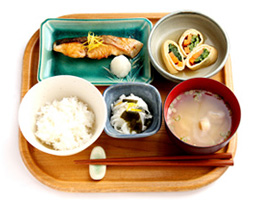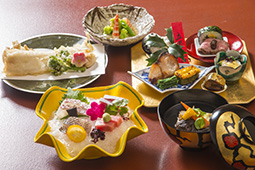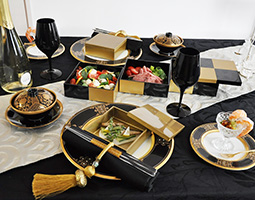INDEX
- English
- 日本語

Traditional Japanese dishware - English
- 日本語

An arrangement of osechi New Year’s food in a lacquered multi-tiered food box featuring kuro-mame (black soybeans) and kazunoko (herring roe) (foreground)

Example of an ichiju sansai meal: rice, pickles, miso soup, vegetables and fish 
Example of a food and dishware arrangement in kaiseki cuisine 
Western-style food served on dishware designed for traditional Japanese cuisine
January 2021
Food and Dishware as Landscapes

The importance of the harmonious arrangement of food and dishware in washoku (traditional Japanese meals) is encapsulated by the expression “dishware is a ‘kimono’ for food.”* Recently, the idea of enjoying beautifully arranged meals that create a harmony between food and dishware through coordinated table settings in the home is attracting attention.

Traditional washoku meals typically comprise what is known as ichiju sansai (one soup and three dishes). At home, for example, the menu includes rice served in ceramic bowls, a soup in a lacquerware bowl, main dishes such as meat or fish served on a ceramic plate, and side dishes such as vegetables, mushrooms, or seaweed served on small plates. Just as the ingredients change with the seasons and various occasion, it is also traditional for the dishware to change accordingly. The one aspect that remains constant, however, is the care taken in selecting the appropriate dishware for the season and beautifully arranging foods. A typical example of the utmost attention paid to food and dishware is the Japanese cuisine served at ryotei (traditional Japanese restaurants) and famous ryokan (Japanese-style inns). Such establishments focus on showing hospitality to guests, arranging carefully selected seasonal foods on ceramic and lacquerware plates that can be considered works of art in themselves, thereby creating what the Japanese call keshiki, meaning scenery or landscape. In Japan, the taste of the cuisine is not the only factor determining the quality of a meal. The choice of dishware also plays a major role. Nishimaki Akiko, representative director of Know and Appreciate Japanese Dishware and who has won many awards at tableware festivals, says, “At the core of Japanese cuisine is an expression of the sense of the seasons. There are also general rules for annual events, such as serving kuro-mame (black soybeans) and kazunoko (herring roe) at New Year’s. Most dishware too represents the four seasons or features designs appropriate for seasonal events. People choose dishware according to the season or event—auspicious patterns for New Year's, for example, or seigaiha (wave) patterns that impart a visual sense of coolness in summer. It’s important to know these basic traditions in order to enjoy a meal.”

In order to choose the appropriate dishware, we need to understand the thought that went into the food, says Nishimaki. “The term kibutsu chinshi means ‘expressing one’s feelings through the use of objects.’ Take special New Year dishes, for example. The reason we eat kuro-mame is because the sound of the word mame (bean) is used in the term mame ni kurasu (“to live well”), which is associated with the meaning of “be in good health.” Kazunoko has the meaning of praying for the prosperity of offspring. It’s important to choose the appropriate dishware paying attention to the feeling that went into the food, to arrange the food on the dishware, to think about how to express that feeling and how to convey that to those who will eat it. If you think about it that way, you will derive even more pleasure from coordinating a table setting.”

As a producer working on coordinating dishware and space, Nishimaki advocates not only using dishware designed for traditional Japanese foods but also mixing and coordinating dishware designed for Western-style food, and even going so far as to serve Western-style food on dishware designed for traditional Japanese foods. “For example, packing a few hors d’oeuvres in a jubako lacquered multi-tiered food box will provide a visual treat when you open the lid, as it will look like a treasure chest. Lacquered multi-tiered food boxes make a good accompaniment to western-style food. Try it and see,” she says.

Of course, food is prepared to be eaten. However, Japanese cuisine offers more—the experience of appreciating a world depicted through food, along with the dishware, as if admiring a landscape.
* An expression bequeathed by artist Kitaoji Rosanjin (1883–1959)

